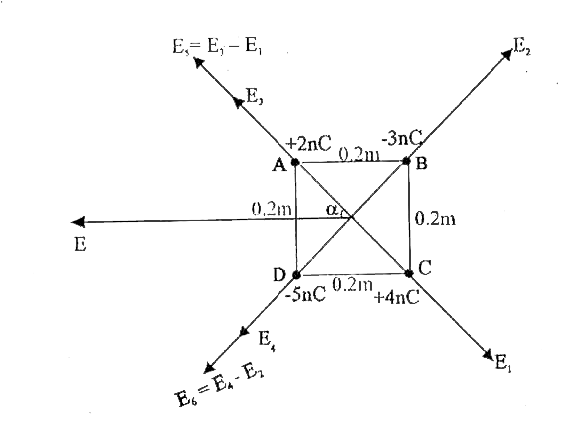Four point charges are placed at the vertices A,B,C,D of a square ABCD of side 0.2 m respectively. Calculate the electric field intensity at a point of intersection of the diagonals.Solution in Kannada
The angles between and and and and

w.r.t or
Topper's Solved these Questions
- ELECTRIC CHARGES AND FIELDSBook:SUBHASH PUBLICATIONChapter:ELECTRIC CHARGES AND FIELDSExercise:FIVE MARKS QUESTIONS WITH ANSWERS
Explore 7 Videos
- DUAL NATURE OF RADIATION AND MATTERBook:SUBHASH PUBLICATIONChapter:DUAL NATURE OF RADIATION AND MATTERExercise:NUMERICALS WITH SOLUTIONS
Explore 21 Videos
- ELECTROMAGNETIC INDUCTIONBook:SUBHASH PUBLICATIONChapter:ELECTROMAGNETIC INDUCTIONExercise:NUMERICALS WITH SOLUTIONS
Explore 19 Videos
Similar Questions
State Gauss's theorem. Obtain an expression for elactric field at any point outside a charged spherical hollow conductor (shell).
View SolutionA photo has a wavelength of 5000 Å. Calculate its momentum.
View SolutionTwo coils wound on the same iron rod so that the flux generated by one also passes through the other. The primary has 100 turns and the secondary has 200 turns. When a current of 2A flows through the primary, the flux in it is 2.5×10−4 Wb. Determine the value of mutual inductance (M) between the coils.
View SolutionCharges of +q,+2q,+q and -q , are placed at the cornersof a square ABCD. Calculate the electric field at the intersection of the diagonals of the square when q=(5)/(3)xx10^(-9) C and length of each side is 10 cm.
View SolutionFour equal point harges each 16μC are placed on the four corners of a square of side 0.2 m. Calculate the force on any one of the charges.
View SolutionABCD is a square of side 4 cm. Charges of 16×10−9C,−16×10−9C and 32×10−9C are placed at the points A, C and D, respectively. Determine the electric field at point B.
View SolutionAt each of the four vertices of a square of side 10 cm, four positive charges each of 20 esu are placed. Find the potential at the point of intersection of the two diagonals.
View SolutionFour point charges of +100 esu,-50 esu +20 esu and +30 esu are placed respectively at the four vertices A,B,C,D of a square of side 10 cm. Find the electric intensity and potential at the point of intersection of the diagonals.
View SolutionIn vacuum, four charges each equal to q are placed at each of the four vertices of a square. Find the intensity and potential of the electric field at the point of intersection of two diagonals.
View SolutionAt each of the four vertices of a square of side 10 cm there is a +20 esu of charge. Find the Intensity of electric fleld at the point of Intersection of the two dlagonals.
View SolutionM is a point on the side AD of the square ABCD such that ∠CMD=30∘. If the diagonal BD intersects CM at a point P , then find ∠DPC.
View Solution8 सेमी भुजा के एक वर्ग के चारो कोनो पर +(103)×10−9C के आवेश रखे गए है। विकर्णों के प्रतिच्छेद बिंदु पर विभव होगा
View SolutionFour point charges, +0.2μC,+0.2μC,−0.2μCand−0.2μC are placed on vertices A, B, C and D, respectively of square ABCD of side a. Calculate the electric potential at the centre of the square.
View SolutionTwo charges of +5nC and -2nC are placed at points (5cm, 0, 0) and (23cm, 0, 0) in a region of space where there is no other external electric field. Calculate potential energy of this charge system.
View SolutionPoint charges of 10nC,20nCand10nC are kept at the corners A,B C of a square ABCD of side 3m. Calculate the magnitude of the resultant electric intensity at D.
View Solution